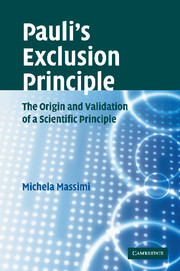Book contents
- Frontmatter
- Contents
- Note on translation
- Preface
- Epigraph
- Introduction
- 1 The exclusion principle: a philosophical overview
- 2 The origins of the exclusion principle: an extremely natural prescriptive rule
- 3 From the old quantum theory to the new quantum theory: reconsidering Kuhn's incommensurability
- 4 How Pauli's rule became the exclusion principle: from Fermi–Dirac statistics to the spin–statistics theorem
- 5 The exclusion principle opens up new avenues: from the eightfold way to quantum chromodynamics
- Conclusion
- References
- Index
5 - The exclusion principle opens up new avenues: from the eightfold way to quantum chromodynamics
Published online by Cambridge University Press: 07 August 2009
- Frontmatter
- Contents
- Note on translation
- Preface
- Epigraph
- Introduction
- 1 The exclusion principle: a philosophical overview
- 2 The origins of the exclusion principle: an extremely natural prescriptive rule
- 3 From the old quantum theory to the new quantum theory: reconsidering Kuhn's incommensurability
- 4 How Pauli's rule became the exclusion principle: from Fermi–Dirac statistics to the spin–statistics theorem
- 5 The exclusion principle opens up new avenues: from the eightfold way to quantum chromodynamics
- Conclusion
- References
- Index
Summary
This chapter explores the heuristic fruitfulness of the exclusion principle in opening up new avenues of research: namely the idea of ‘coloured’ quarks and the development of quantum chromodynamics (QCD) in the 1960s to 1970s. Sections 5.1 and 5.2 reconstruct the origin of the quark theory from Gell-Mann's so-called ‘eightfold way’ for elementary particles. The experimental discovery of the Ω− particle confirmed the validity of Gell-Mann's model, but it also provided negative evidence against quarks obeying the exclusion principle. Two alternative research programmes emerged in the 1960s to deal with this piece of negative evidence (Section 5.3): the first programme (Section 5.3.1) rejected the strict validity of the exclusion principle and explored the possibility that quarks obeyed parastatistics; the second (Section 5.3.2) retained the exclusion principle and reconciled it with negative evidence by introducing a further degree of freedom for quarks (‘colour’). The Duhem–Quine thesis seems to loom on the horizon (Section 5.4): the choice as to whether questioning the principle or introducing an auxiliary assumption to reconcile it with negative evidence seems to be underdetermined by evidence. However, I shall argue that it was exactly via the development of these two rival research programmes that the exclusion principle came to be validated, and that there was a rationale for retaining the principle despite prima facie recalcitrant evidence.
Introduction
As we have seen in Chapter 4, soon after 1924 Pauli's exclusion rule was incorporated into the growing quantum mechanical framework, where its role came to be redefined and its nomological scope extended.
- Type
- Chapter
- Information
- Pauli's Exclusion PrincipleThe Origin and Validation of a Scientific Principle, pp. 145 - 183Publisher: Cambridge University PressPrint publication year: 2005



